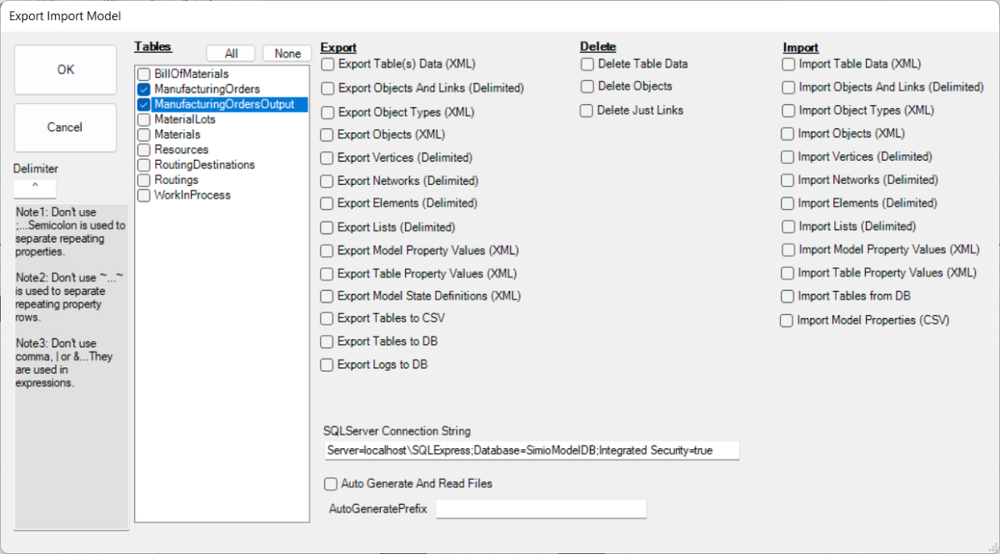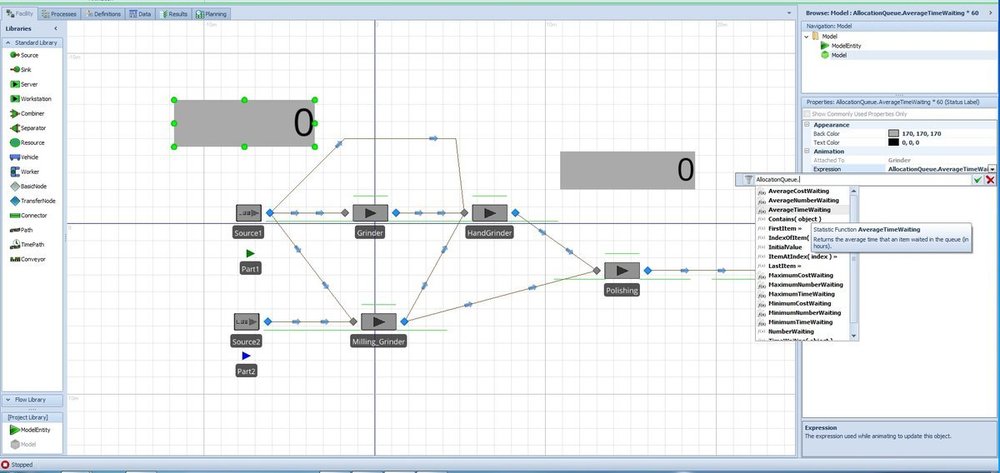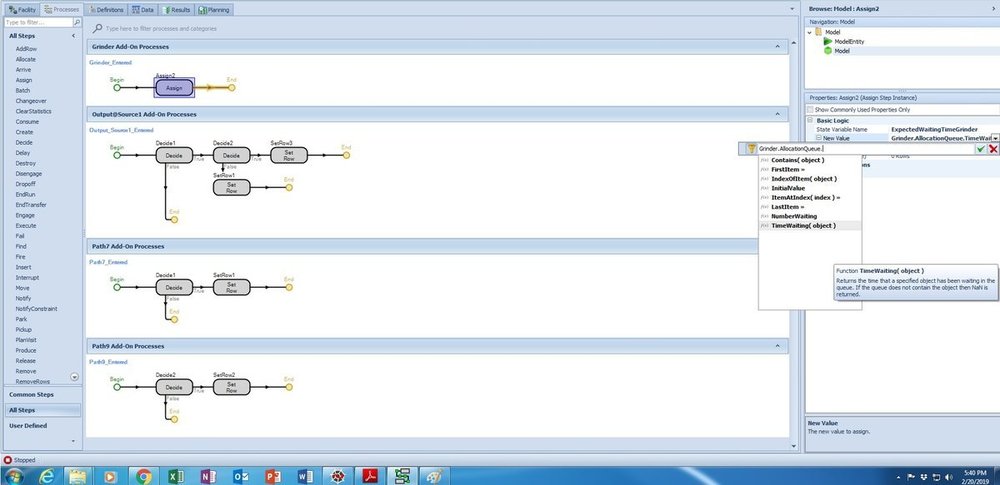Search the Community
Showing results for 'time blocked on network'.
-
Hi All, I have a query. Is there a way to implement logic that allows the model to vary the processing time of a server as a function of the available man power? In my model I have various servers and all need a specific number of workers in order to begin processing. I have one large pool of workers to be shared between all stations. This means that there are times when all the workers are in use and times when some are spare. Ideally I would like to model that when there are men spare they would come and help other stations and get the job done quicker or when only some of the required quota of workers are seized they can start the work all be it at slower pace until the full quota has been seized. I hope this makes sense Thanks
-
Hello, I am working on evacuation network design problem. My network has several evacuation areas (source nodes), road segment, and shelters (destination nodes). I consider congestion as people might stick in the traffic and they have to reduce their speed in the road. My goal is to send people from hazard areas to safe areas in the defined time horizon. So my first question is that, can I use SIMIO for simulating my model? Since my model has limited time for evacuation (Terminating problem), can I validate my problem with replications, if yes, how many replications I need? 2) Is there any other method to validate my model? Thanks,
-
Hello Can simio use time series data (say from an excel file) as cost input for servers, that updates every hour?
-
Here is a simple utility that will export, import and delete artifacts of your model. Here is a screen shot of the available capabilities. The code and DLL have can be found on SImio GitHub. Please find at this link: https://github.com/SimioLLC/ExportImportModelAddIn You will also find install instructions in the ReadMe. Here are the changes that have happend over time: Updated 2023-01-31....Added the ability to select multiple tables for export and delete table data functions. Updated 2022-10-05....Updated the exports to sort the data first my name and then export. This ensures that the data exported is in a consistent order. Updated 2021-12-07....Added the ability to select a table and then remove the data from the selected table. If a table name is not selected, all the tables in the model will have their data removed. Updated 2021-09-20....Added Update Model Properties (CSV). With this new method, you can import model properties into your model. If the file contains 3 fields...First is name, then type and last is default value. The only valid types are real, datetime, Boolean and everything else is string. If the model property already exists, it will only update the default value on the property. Note: The example assumes the field separator is a caret '^'. To change this, you need to change the delimiter field. Updated 2021-09-08....Updated the sequence of the exports, deletes and imports happen. When OK is pressed, first the exports are run, then deletes and finally the imports. With this change, I am able to Export Table to DB, Delete Table Data and Import Table from DB from in a single run. I typically do this when re-mapping auto creates elements. Since the table data need to be removed and recreated before mapping of the elements are correctly mapped. Updated 2021-09-06....Upgraded to .NET 4.7.2. Also, fixed the windows form so it displays correctly. When opened, the form should no longer need to be expanded to see all the options. Updated 2018-11-08....Added Export To CSV, Export To DB and Import From DB. Export To DB will create a table in the SQL Server database with the same table name as the table in Simio. The data columns will be of type nvarchar(max) and the default value will be the same as the default value in the Simio table. It is assumed that Simio desktop will still do the data validation, not the database. This feature is used to save the Simio data into a database so it is backed up and can be shared across users. Each time the Export To DB, if the table already exists, it is dropped, and a new table is created. This ensures that the data schemas match between the Simio model and the SQL Server database. Updated 2017-12-05....Fixed index issue with links import. Updated 2017-09-25....Fixed the import of lists. Updated 2017-07-14....Added the ability to auto generate and auto read files. Previously, the files needed to be created prior to running the add-in. Now, they will create by the export. Also, the import will retrieve the same file generated by the export. These options are available when the "Auto Generate and Read Files" option is selected. Updated 2017-07-13....Added the ability to multi-select options. Now, more than one option can be initiated when the OK button is selected. This will streamline the process of exporting, deleting and importing. This tool is very helpful for testing out your model with various configurations to ensure that runs properly under various object and/or data configuration. Updated 2017-07-11....Now supports exporting and importing of model properties, exporting and importing of table properties and delete table data. Updated 2017-06-22....Now supports exporting and importing of data tables using XML. This is simple way to export all the table data from one model and import the same data into a new model (assuming that the same tables schema exists in the new model). Updated 2017-01-27....Now supports exporting of object types using XML. This can be used with the new Configure Scheduling Resources in Simio 9.150 capabilities to define your own object type properties based on an XML document. Updated 2017-01-23....Now supports exporting and importing objects using XML. When using XML, property units are also exported and imported back in. Updated 2016-10-24....Updated files...Added support for repeating properties.
-
New to Simio and learning as I go. The attached model includes a CombinerNode1 that batches entities in groups of 2 & 5 (random.discrete). I would like Server1 to use different processing times for the different batch sizes. For example, a batch of 2 entities should be processed in 5 seconds; Batches of 5 entities in 7 seconds, etc.. Eventually I will create batches of up to 6 entities. I have tried using Server1.Processing.Contents for Processing Time, but seems to return the value of 1 all times. Any help is appreciated! Thanks! Processing time based on BatchSize.spfx
-
Hi, I am trying to make it so that at the end of a process all of my combiners (say 10 or 20) collect all entities (assigned to a particular combiner when they enter the system) but wait to release to the sink until the simulation reaches a certain time (say 9:00 AM) AND all entities have been processed through the system and are in their assigned combiner. I use a combiner because they turn into a different type of entity before exiting the system. I've tried a few different things but cannot seem to get the process logic down. Any help?
-
I'm having trouble calculating the average time between Objects. I know there's some built in function called time in system to get entity totle time in the system. But now I care the time entity spent between nodes. EG: I have entityA, entityB, entitleC, I want to find the entityA average time spent from server1 to the server6, from server1 to the very end, from the very begining to server4? How should I do these, what does the expression look like? I want to add a label to show that numbers dynamically during the run of the model.
-
My simulation is looking at maintaining inventory levels at multiple servers across a road network. Inventory is delivered via transports and is processed at each station at a rate of 1 item per hour (constant). What I am trying to do is to run some experiments to determine effects of different parameters on delivery system performance (ability to maintain inventory at (between 0-12) at each server location for the duration (72 hours is the current short test case). I have my responses set up to report Input@Server1.AssociatedStationLoad however the numbers are being listed between 0 and 1 instead of 0 and 12. Additionally, in the experiment output I get a 1 or 0 per server per scenario iteration. What I need to see is if any (and what) server hits 0 at any given time by having an output give an inventory level at current time for the duration of each run. Any advice?
-
Hello! I posted a question while building a human-accessible elevator using SIMIO. The modelentity couldn't build its own system to get off the elevator, so I made the appearance of the elevator using a worker. At this time, I want to make the elevator stop from the low floor to the high floor, but the elevator is stopping randomly. For example, the elevator should stop in the order of the first, second, and third floors, but it stops randomly, such as the third, second, and first floors. I want to know the solution accordingly! I will attach the file for your understanding. Lift Project.spfx
-
Accessing parentinputbuffer time waiting combiner
ViniciusF replied to piedz's topic in SI General Discussions
Is it fair to say that the longest waiting time in the parent queue is the first entity at the queue? If so, you could use something like: Candidate.Node.AssociatedObject.Combiner.ParentInputBuffer.Contents.TimeWaiting(Candidate.Node.AssociatedObject.Combiner.ParentInputBuffer.Contents.FirstItem) to access the combiner which has the largest value of the time waiting of the firstItem in the queue. It seems to work -
Hi, We want to track the avererage waiting time from when an entity is created until it allocated to a server. We already have the waiting time in formula TimeNow - Model.Entity, but we can't figure out how to get it in the results grid so that we can see the average waiting time. Apoteksimulering (1).spfx
-
Thank you very much for your help, but simio says I can't use the Release step with the server because I don't have any resources to release. In addition, although the Search step works very well, since I don't have any step that keeps the entities inside the server even if they are not called, they continue to leave the server and merge with entities that should not be merged. If I set the processing time to infinity, despite calling entities with the Search process, the entity does not leave the server. I tried to condition the processing time of each entity according to the "Ventana_de_entrega" state, but as expected, it is not the most appropriate. 21.10.spfx
-
thank you, it really helps a lot. do you have any idea to record the total time of the car loaded and empty travel time? i have subclass the vehicle, define a vehiclelist with different string and modify the vehicle process "oncapacityallocated", "onriderloaded" and "onriderunloading" als emptytravel and loadedtravel. But i works not so good, the time are not so correct. Especially when i define the "load time" and "unload time", these time are also counted.
-
Well, first thing, you don't need your entities to be bouncing between the output and the input of your server like that. If you want to use it as sort of storage, set both the processing time and the capacity to infinity. After that, at the moment that the parent entity enters the combiner "Parent Entered" you could search the queue of your storage using a search step with something like "Server1.Processing.Contents", with the condition of "Candidate.ModelEntity.State == ModelEntity.State", release the server and transfer what have been found to the output. You need to take some care on some situations, like what if the parent entity arrives first at the combiner then the member at the storage? And some care with batching quantities aswell. But I think you can handle it.
-
Hi, It is possible to add a tear-down time in a server? I have a server with a capacity over 1, so I would like to add a tear-down time to simulate the cleaning of a bed in a hospital after it was used. Thanks!
-
Hi all!, would you help me with this? I want to do a discrete simulation of the current situation in a Hospital in the inpatient unit. I have the data of one year of patients, (over 18,000 people) and I want to use that data in the simulation. That would make more easy to model the server processing times, while we will use the real server times and sequences that each patient had, instead to use probabilities and distributions for the sequence and server times respectively. So, I created a table where each row represent a patient with a sequence (which bed he was assigned due to his level of acuity) and the time that he spent in that bed before he was dispatched. The are more times involve, but we can focus in those parameters to have it more simple. So, the table have the patient name (entity) ,bed (sequence) and Length of Stay in the bed (server processing time). I don't know if is possible that when I create each entity, I can assign, based on that table, the sequence and the server processing time for each patient. How I can do that? Thanks for your time and help
-
I have a task sequence model using the Immediate Predecessor method. I would like to add in a rejection rate for each task, and then a unique processing time for the rework. Is this possible?
-
I have a problem with producing/consuming within my TaskSequence. I need multiple task operation (prepare -> work -> clean -> produce), where I'm also consuming/producing material defined inside my BOM table. When I'm trying to reference material requirements on the BOM table I get an error: "Could not determine the row to use in the referenced table or repeat group ...", references to the processing time and other parameters are working fine. If I set the task sequence reference to the BOM table, then material requirements works OK, but I could not add more than 1 task. I'm using version 15.241.27814 . Best regards, Žan
-
I am trying to make a routing decision based on the Candidate node's routerequestqueue's summation of the entities user-defined property. If there are different types of entities with ex. different priority levels. I would like the routing process to choose the transfernode which has the smallest total sum of it's entities priority level. the transfernode that needs to be chosen also has a routing group attached to its entity destination type rule where its final machine has 0 buffer and due to a blocked destination rule, there will be a queue build up at the transfernode that needs to be chosen. I have thought about using a state variable for each node and using add-on process each time a unit enters and leaves a node but because the main model has many multiple nodes the node's entity priority sum has to be able to be accessed through the candidate.transfernode._________________. For example during the routing step in the process section, I have candidate.transfernode.destinationroutinggroupname.routerequestqueue which gives me the node's number of units waiting, but i need to be able to access the candidate nodes summed queued property. Is there either a way to directly access this information, have looked at the expressions and having a hard time finding something. failed attempt: candidate.transfernode.destinationroutinggroupname.routerequestqueue.population.defaultentity.priority.summation or is there a way to use the add-on process where i am adding/subtracting the priority levels, but somehow attach it to the candidate.transfernode's property Hopefully this makes sense. If you look at the file, please ignore the upper half and focus on the transfer nodes maintransfer, transfernode1 and transfernode1_1. maintransfer has an entered add-onprocess which is the subject of this question. the route process and it's selection expression is what I'm trying to adjust but find a way to express the candidate transfernodes of transfernode1 and transfernode1_1 (which are part of the XferRouting group). I'd like to choose and compare the total summed priority level of each node's queue. Simple_Routing.spfx
- 2 replies
-
- routing
- expressions
-
(and 2 more)
Tagged with:
-
I'm simulating a workflow, now between two servers, there's a delay between them, we could understand it as some out-of-control waiting time or simply travel time between 2 servers. I don't know how to set this travel time perfectly. I tried set 'path' speed, but I don't think it setting that can make the time randomly… because in my situation, the delay processing time can be random. I can add another server called 'delay/travel machine' to solve this problem perfectly, but it just looks ugly and weird… So I'm wondering if there's a better solution for this?
-
Hi, I am new to Simio. I was trying to add a routing decision in my model based on average time waiting at a server. But this function only shows up in the status label but not when I try to use it in the Processes as shown in the images. An entity reaching a node should choose the route to a server which has minimum average time waiting. What I am trying to achieve is to create a dynamic routing so that the average Time in System of the entity will be minimized. I don't know whether this is the right method or if we need to work with API or functions to achieve this. Any help would be much appreciated. Thank you in advance.
-
Hi - first of all, this add-in is awesome! Thank you!! I'm running Simio software version 15.244.28783.0 and just encountered this error: Wondering if IModel was updated to require get_ActiveModel(). I haven't tried running this on an older version - will attempt that if I can make the time. Can you point me in a direction? Unfortunately, I won't be able to share the model.
-
Hello every body, I try to model a 3 servers process and I'm getting some trouble. The model is composed of 3 servers and 3 operators . Each operator is a "specialist" for a server, Worker 1, 2, 3 for the server 1, 2, 3 respectively. However the workers 2 and 3 can help the worker 1 at the server 1 if they are not busy. The processing time of server 1 will adjust proportionally to the number of workers working at the server. (There is a 4th worker whose task is to move parts to the server 3 or the sink. But I don't think it plays any role in the problem.) I've implemented some processes so that workers work at the right server. It was working perfectly. But then, as I modified the model to add the variable processing time, the Interrupt steps in the processes don't work anymore. Indeed, the worker 2 or 3 stay at the server 2 or 3 and don't go to help the worker 1 when servers 2 or 3 are blocked, or idle. As well, if workers 2 or 3 are busy at server 1 they are not interrupted when a part arrive to the server 2 or 3. I hope I'm clear enough. I've enclosed the model so that you can better picture the problem. Thank you for your attention and thank you in advance for any help I may get! three_workers_Interrupt.spfx
-
I need to simulate a crane moving entities between different points. But the problem is the load and unload time are not the same in all those points. I need to be able to define somehow the crane load & unload time as a variable (node depending). I wonder if anyone has dealed with this problem before? Rds.









